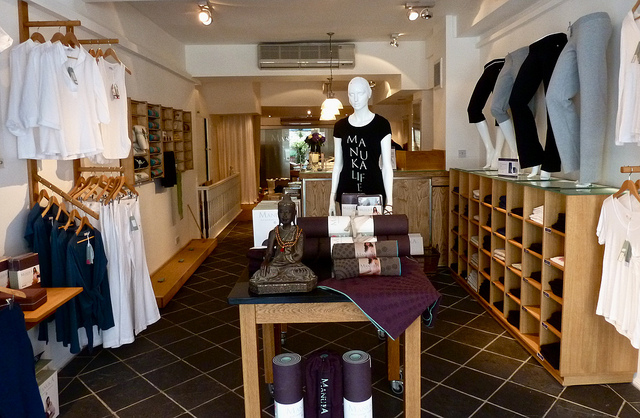In the past four years since I started teaching yoga, I have been telling my students the following: What you wear to yoga doesn’t matter. As long as it is comfortable and you can move around, it’s okay.
I always thought I would feel that way, but now I no longer do so.
What we wear to yoga and everywhere else does matter.
To be clear, I am not talking about style—sweatpants, leggings, t-shirts, tanks, it’s all good.
However, what we wear, in the sense of where and how it is made, does matter.
The trend towards fast, cheap fashion is something that I have written about in the past. By cheap, I am not necessarily talking about the price tag, but stuff that doesn’t last and isn’t meant to.
Since I first wrote about the topic over a year ago, it seems like the trend towards cheap, disposable clothes has continued to grow and may even be stronger than it was when when I first addressed it.
Just speaking anecdotally, the mere mention of paying more for clothes leaves many grimacing in horror. The most common question I am asked is, “Why would I spend more if I can pay less?”
My reply: “Cheap fashion isn’t really cheap.”
Indeed, it isn’t. Just speaking for myself, I noticed that stuff from places like Old Navy, Forever 21, Target, etc. typically doesn’t wear as well or last as long as ethically-made clothing. Not only are the things typically made better, but the materials tend to be better as well.
Nowhere was this more apparent than at a screenprinting workshop I took last month. The t-shirts that were brought in all came from various cheap retail chains. Not only did they feel like tissue paper, but it was clear that none of them were designed to last a year, much less several.
Plus, a lot of stuff from the discount chain stores commonly contains plastic of some sort. Plastic isn’t renewable or biodegradable. Lest we think, “Well, I can always donate it to the thrift shop!” as Elizabeth Cline points out in her amazing book, Overdressed: The Shockingly High Cost of Cheap Fashion, thrift stores have reached their quota. Many of our donated clothes end up landfills.
Then there is the very real, very human cost of the people who make most of our clothes. The horror of sweatshop conditions are well-document especially in light of the Savar building collapse in Bangladesh back in 2013.
Therefore, what are most of us to do, especially those of us who don’t have unlimited money to spend on clothes?
The solution that I have found is buy better and buy less.
Sometimes that means scouring Ebay for deals on good used clothing or saving up for well-made, ethically made clothing from places like Wellicious and Balini Sports which have some of the nicest selections of workout gear I have ever seen.
Another plus of having clothes that last, is the memories that come to be associated with them. Like many people, my clothes have a history. When I put on a certain item, I can be transported back in time to the last time I wore it. Since I have started buying well-made yoga clothing, I have tops and pants that go back nearly a decade and I can remember the various workshops and retreats I wore them, too.
Same with vintage. It’s nice to have clothes with history and wonder who possibly owned them before they came to me.
In any event, the case for sustainable clothing could not be more relevant as more people are becoming very much aware of environmental degradation.
Indeed, I argue one cannot really call themselves an environmentalist or humanitarian and not be aware of how most clothing is made.
The time has come for slow fashion/ethical fashion to stop being a niche market and for everyone.
Relephant:
The Yoga Pants Phenomenon.
~
Author: Kimberly Lo
Editor: Travis May
Photo: Flickr/Herry Lawford
~
Facebook is in talks with major corporate media about pulling their content into FB, leaving other sites to wither or pay up if we want to connect with you, our readers. Want to stay connected before the curtain drops? Get our curated, quality newsletters below!



Read 3 comments and reply